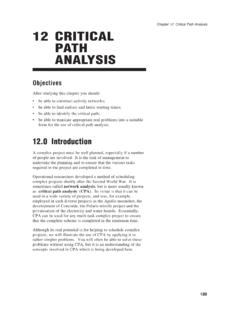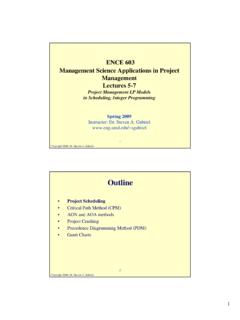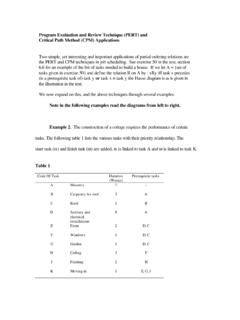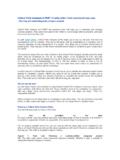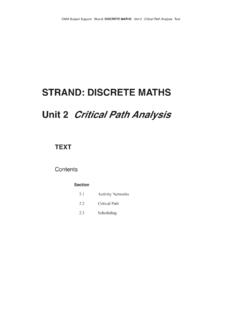Transcription of Critical Path Method - dssbooks.com
1 Twelve Critical path Method Application Overview and Model Development Worksheets User Interface Procedures Re-solve Options Summary Extensions case study OVERVIEWCASE STUDY CASE STUDY 12 Critical path Method Application Overview and Model Development The Critical path Method is a quantitative technique to manage projects. This technique models a project as a network of several activities. Each activity has an associated activity time that denotes the length of the time needed to complete the activity. Activities also have precedence relationships between them; in other words, an activity can be started only when other activities are completed. The Critical path Method (CPM) seeks to determine which path , or set, of activities is Critical to completing the project. Related to the Critical path Method , the time-cost tradeoff problem entails crashing, or reducing, the activity times to a crash time at a given crash cost.
2 Depending on the structure of the activities network, there may be several different ways in which the activities can be crashed in order to reduce the overall project time at a minimal cost. As activities are crashed and the project time is reduced, the total project cost is increased, which creates the time-cost tradeoff. The time-cost tradeoff problem is to determine for a desired overall project time which activities should be crashed in order to minimize the total crash cost, or total project cost. In this application, the user can either find the Critical path of the project or create a graph of the time-cost tradeoff from crashing activities. For the Critical path Method option, the user creates a project network, provides the activity times and costs, provides a precedence matrix of the events, and then views the Critical path of the project with the total project completion time.
3 For the time-cost tradeoff option, the user creates a project network, provides the activity times and costs along with the crash times and crash costs, provides a precedence matrix of the activities, and then views the time-cost tradeoff as the project is crashed for various project times. Model Definition and Assumptions For the CPM option, the user provides information about the activities. Here, we assume that the project network is represented by nodes as events and arcs as activities that connect those events. For example, in the network pictured below, there are six events and seven activities. The numbers written above each activity and each arc are the activity times. 1233555468642 To create the precedence matrix for this network representation, we create a matrix with the number of rows and number of columns equal to the number of events.
4 Then, if any event in row i precedes an event in column j, then the activity that connects these two events is written in cell (i, j). The table below is the precedence matrix corresponding to the network above. CASE STUDY 12 Critical path Method 3 1234561142323645576 The CPM then computes the early start time (the earliest time the activity can start) and the late start time (the latest time the activity can start) for each activity. Early start times are calculated by analyzing the network activities from the beginning to the end of the project. This analysis is performed using the precedence matrix; the matrix is scanned over each row i = 1 to the number of events and over each column j = 1 to the number of events. The following If, Then statement calculates the early start times based on the activities found in the precedence matrix.
5 [Here CurrentAct is the activity listed in a cell (i, j).] If EarlyTime(j) < (EarlyTime(i) + ActDuration(CurrentAct)) Then EarlyTime(j) = (EarlyTime(i) + ActDuration(CurrentAct)) End If The application calculates the late times by analyzing the network activities from the end back to the beginning of the project. This analysis is performed using the precedence matrix; the matrix is scanned over each row i = number of events backwards to 1 and over each column j = number of events backwards to 1. The following If, Then statement calculates the late start times based on the activities found in the precedence matrix. [Here CurrentAct is again the activity listed in a cell (i, j).] If LateTime(i) = 0 or LateTime(i) > (LateTime(j) - ActDuration(CurrentAct)) Then LateTime(i) = (LateTime(j) - ActDuration(CurrentAct)) End If From these times, the free float and total float for each activity are computed using the precedence matrix.
6 If there is an activity in a cell (i, j), then the following calculations are performed: FreeFloat(CurrentAct) = EarlyTime(j) - EarlyTime(i) - ActDuration(CurrentAct) TotalFloat(CurrentAct) = LateTime(j) - EarlyTime(i) - ActDuration(CurrentAct) The CPM can now determine the Critical path of the project. Any activity with a total float time of zero is on the Critical path . The total project time and the total project cost are updated based on these Critical activities. If TotalFloat(i) = 0 Then ProjDur = ProjDur + ActDuration(i) ProjCost = ProjCost + NormCost(i) End If For the time-cost tradeoff option, the user provides the project network and activity information including the crash times and crash costs for each activity. Here, we assume CASE STUDY 12 Critical path Method 4that the project network is represented by nodes as activities, and arcs represent the ordering of those activities.
7 For example, in the network pictured below, there are seven activities. The nodes s and t are dummy sources and sink nodes respectively; they represent the beginning and end of the project. 1567432ts To create the precedence matrix for this network representation, we develop a matrix with the number of rows and columns equal to the number of activities + 2. (The additional two activities are for the dummy s and t nodes.) Then, if any activity in row i precedes an activity in column j, the number 1 is written in cell (i, j). The table below is the precedence matrix that corresponds to the network above. s1234567ts11111213141516171t The application then solves a linear programming model to find the best selection of activities that should be crashed to minimize the total project cost for a desired project time.
8 We solve this problem iteratively for various desired project times. The linear programming problem is prepared in a hidden worksheet and solved by the Solver. The parts of the model and the formulation for this problem are below. (Figure presents the hidden worksheet with the prepared model.) Decision Variables: Start time per activity, u(i) Crash time per activity, B(i) Constraints: Crash times should be less than or equal to the difference between the activity time and the crash time provided in the activity table. B(i) ActDur(i) CrashDur(i) The total project time must be less than or equal to the desired project time. Start time of end Start time of beginning <= desired project time u(t) u(s) P CASE STUDY 12 Critical path Method 5 Using the precedence matrix for every cell (i, j) with a value of 1, the start time of activity j should be greater than or equal to the start time of activity i plus the activity time for i minus the crash time for i.
9 Start time(j) >= start time(i) + ActDur(i) CrashTime (i) u(j) u(i) + ActDur(i) B(i) Objective Function: Minimize total project cost = SUMPRODUCT(decision variables, crash slopes) (crash slope (i) = ABS((CrashCost(i) NormCost(i)) / (ActDur(i) - CrashDur(i)))) Model Formulation: Minimize i BiSi , Si = crash slopes or cost per time unit crashed Subject to: Bi Ai Ci , Ai = activity time and Ci = crash time ut us P uj ui + Ai Bi Bi 0 ui 0 Figure The hidden optimization sheet. The time-cost tradeoff graph shows the project cost achieved from the crashing model for each iterative project time. In this graph, the total project cost includes the sum of the normal activity costs. The resulting graph should be a piece-wise linear convex function. For more details on the Critical path Method or time-cost tradeoff problem, please see Introduction to Operations Research by Winston.
10 Input The input for the CPM option is the following: Project network with nodes = events and arcs = activities Activity times and costs Precedence matrix of the events CASE STUDY 12 Critical path Method 6 The input for the time-cost tradeoff option is the following: Project network with nodes = activities Activity times and costs along with the crash times and crash costs Precedence matrix of the activities Output The output for the CPM option is the following: Critical path of the project Total project completion time Event early start times and late start times Activity free float and total float times The output for the time-cost tradeoff option is the following: Time-cost tradeoff graph for various project times and costs Worksheets This application requires seven worksheets: the welcome sheet, the network sheet, the activity table sheet, the precedence matrix sheet, the CPM output sheet, the time-cost tradeoff output sheet, and the hidden crash LP model sheet.

